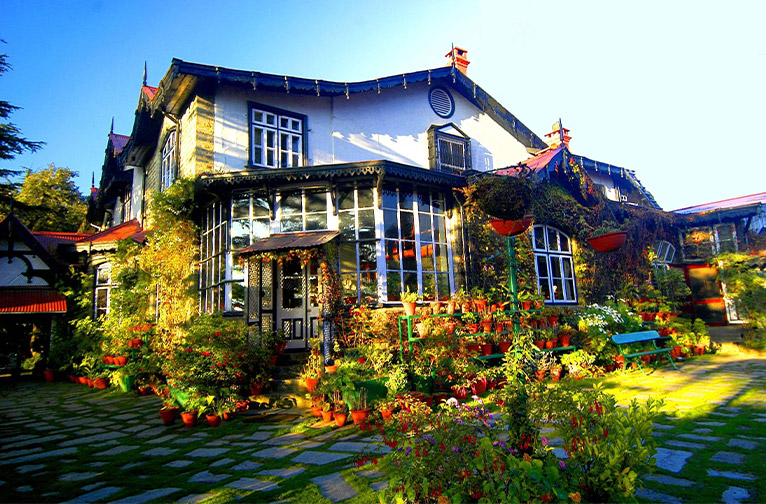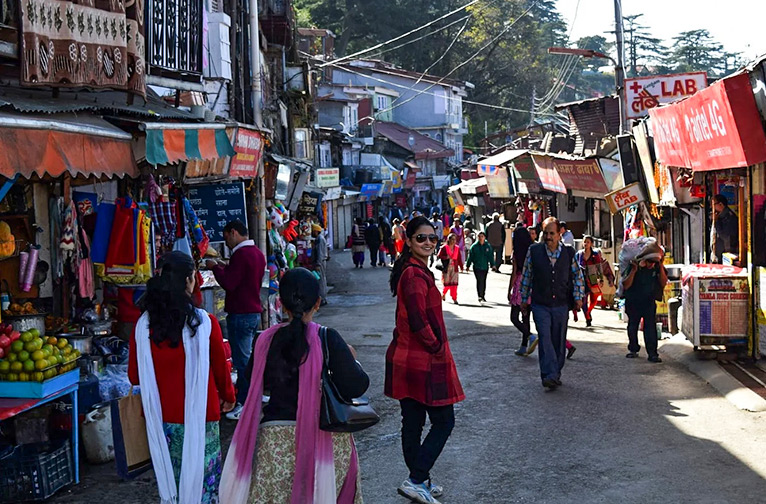Tendrils of mists rise up from the folds of the Shimla hills, wrapping themselves moistly on buildings old and new; the lofty pines and deodars sigh with relief as the unseasonal heat is chased away by the first monsoon showers, leaving them green and lush once again.
Leaving behind Delhi, still desperately waiting for the monsoon, despite the intermittent showers which fooled us all, we wind our way up the mountain trail to Shimla, where the rains are on in earnest. Thankfully for us, who tend to get car sick on hill drives, the ride up to Shimla isn’t as half daunting as the vertiginous, hair-pinned drive to Mussoorie at 7000 ft.
In the early days of the Raj the haul up to Shimla the summer capital of British India from 1864, along the steep, rough-cut, pot-holed trail, was done by horses; and if the memsahibs were travelling along with kids, it was normally by doolies, a canvas stretcher-like contraption (like jampans) with poles, shouldered up the winding road by sturdy hillmen. Tongas were another option. Only the lamps attached to the carriage would light up the dark trail. One missed step and accidents could happen. Even the Viceroy had little choice when it came travelling from Delhi to Shimla, the summer capital of the Raj in India. The journey itself took several days to complete. The Kalka-Simla rail track was only operational in 1903.
The striking the red and cream-coloured seven-storied Railway Board Building located on The Mall in Shimla is a lasting reminder today of the pivotal role the railways played in connecting India during colonial rule.
Cooling mountain breezes had by now revived us sleepy heads and gung-ho about our monsoon break in Shimla we looked around us with renewed interest. Along the road we spied stately pines and even the vibrant red rosettes of the rhododendrons peeping from behind a stand of silver oaks.
Self-Discovery Heritage Walk
The star points of the self-discovery heritage walk, which we had chalked out for ourselves, served as an engaging history lesson for those in our party who didn’t know much about this hill town. They just wanted to revel in the beauty of a Shimla monsoon!
We kicked off our walk at the iconic creamy-toned Christ Church, where tourists gathered in great numbers, occasionally joined by a band of playful langurs from nearby Jakhu Hill with its ancient Hindu temple. The neo-Gothic structure of this church is pretty striking as are the superb stained-glass windows, the handiwork of John Lockwood Kipling, the father of no less a person than Kim author, Rudyard Kipling. John Kipling, an illustrator of high note, later went on to serve as the curator at the Lahore Museum. You can also see his artistic prowess at work in the form of his Bas-relief representing Trade at Crawford Market in Mumbai.
Walking down the hilly slope we join the famous Mall Road, awash with locals and tourists, using folded umbrellas as walking sticks while eyeing the offerings on display in the shopfronts.
Looping back on Mall Road, we take a pause at the famous Gaiety Theatre, a bustling hub in the Raj days for its bill of fare of amateur theatrics in the plays by the English ladies and gents, such as Lord Lytton and Rudyard Kipling, who were here for a summer sojourn. Notable Indian artists who showcased their theatrical mojo here were Prithviraj Kapoor, Balraj Sahni, Pran, Shashi Kapoor, Naseeruddin Shah, Anupam Kher and many others. The complex hosts a vast variety of cultural activities such as exhibitions, musical evenings etc apart from plays. We just enjoyed the wind-back-in- time at the Gaiety on this trip as we just wanted to use our time in Shimla being out and about.
We swept past the grand stone and timber Town Hall dating back to 1908, taking note of clerks and admin honchos scurrying in and out of this primary administration hub of Shimla. We marked our presence by the General Post Office, sequestered in what was the Conny Cottage from 1883.
Scandal Point, located here is no longer a point of scandal. Even writer Khushwant Singh pooh-poohed the viral rumour that this is where Patiala’s colourful Maharaja Bhupinder Singh had abducted the Viceroy’s daughter in 1892. Singh’s contention was that the said maharajah was only about a year old at the time, so it was really a far stretch of imagination for him to have done the foul deed. It appears that the Maharajah in question was most likely Rajindra Singh, who in fact married (quite legally, with both Hindu and Sikh rites) an Irish woman, Florry Bryan, a ‘quiet modest girl” in Patiala!
We broke for lunch at the Cecil, because by now we’d got caught in a massive downpour. We girls found refuge in the loo, where we frantically dried our hair with towels and the hand dryer! The Cecil Oberoi is one of the most iconic hotels of this famous hospitality chain. It is from here where he worked as a front desk clerk that Mohan Singh Oberoi dreamt his dream to be a hotelier. Fuelled by his driving ambition, the money from selling his wife’s jewellery and mortgaging his assets he bought out the Clarkes Hotel in 1934. The ambitious young man even bought out The Cecil a couple of years later!
When the rain finally let up after an hour or so we headed out to our last stop, which was the Viceregal Lodge, now Rashtrapati Niwas, built in 1888. Walking through the elaborate gardens we soaked in the earthy scent of the rain-kissed expanses of this grand Scottish-style baronial castle. It had witnessed the intense confabulations between British Viceroy Mountbatten and the Indian leaders in 1945 and 1946 on matters pertaining to India’s Independence and the partitioning of India and Pakistan. Though it's home to the Indian Institute of Advanced Study now, we took a guided tour of the touristy portion of the VC.
Mall Trawl- for foodies
Returning to the Mall we dived into yummy hot pakoras, samosas and tikki chaats. We wolfed down hot jalebis. Taking full advantage of Shimla’s rainy days, we chomped on roasted bhuttas (corn cobs) slathered with spicy masalas and squeezed lime juice. We picked up early cherries and lush plums from a smiling gap-toothed vendor. We pushed through the thick crowds to gobble up hot gulab jamuns, washed down with spicy masala chai.
Gracious Chapslee
Having stuffed ourselves, and vowing not to eat a bite for dinner, we headed back to the cosy warmth of the almost 200-year-old hotel, The Chapslee, owned by the Kapurthala royals. We fell in love with this lovely hotel, close to Lakkar Bazaar, while browsing through the Net for heritage options in Shimla. Steeped in atmospherics and heaps of charm, this lovely property was built atop Elysium Hill in 1830, Chapslee was included in the book ‘1000 Places to See Before You Die‘ by Patricia Schultz. How could we resist!


We were excited about delving into the delights of the ‘Chapslee Experience’, a unique offering of grace and elegance from bygone days. Powered by richly personalised service and homey warmth it indulges you with traditional high teas and dress-for-dinner kind of meals. We sank into the magic of its nostalgia-dripping, silver and crystal accent pieces set against cheery chintzes, which mark its five plush suites. We drank our whiskeys neat and wines by the glass by the fireside, before calling it a night.
We rose to a morning filled with rain, but just dreamed away our time watching the rain drops on the panes in the glassed-in Glazed Room, a tranquil conservatory, surrounded by flowering pots and greens…